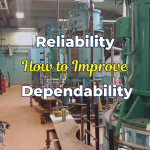
Organizations can systematically enhance reliability and dependability by integrating key approaches into the development, deployment, and maintenance processes of their products and systems. Systems thinking rules! Despite subtle differences in terminology, regular assessments and updates should be conducted to address emerging challenges and technological advancements. This article provides a brief description and demonstration of several key approaches for enhancing reliability and dependability.
Reliability and Dependability Are Often Used Interchangeably
When it comes to choosing the right word to describe a product or service, the terms “reliability” and “dependability” are often used interchangeably. However, there are subtle differences between the two that can impact how they are perceived in practice and by consumers.
[Read more…]













 Ask a question or send along a comment.
Please login to view and use the contact form.
Ask a question or send along a comment.
Please login to view and use the contact form.